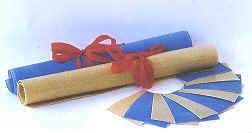PE
HETEROGENEOUS ION-EXCHANGE MEMBRANE
 PE heterogeneous ion exchange membrane is made from
styrene sulfonic acid type cation-exchange resin and styrene quaternary ammonium type
anion-exchange resin, with PE as adhesive agent. They are plasticated on two rool mills
set on nylon web and laminated into PE cation-exchange membrane (hereinafter referred to
as cation membrane) and PE anion-exchange membrane (hereinafter referred to as anion
membrane).
PE heterogeneous ion exchange membrane is made from
styrene sulfonic acid type cation-exchange resin and styrene quaternary ammonium type
anion-exchange resin, with PE as adhesive agent. They are plasticated on two rool mills
set on nylon web and laminated into PE cation-exchange membrane (hereinafter referred to
as cation membrane) and PE anion-exchange membrane (hereinafter referred to as anion
membrane).
Ⅰ.PRINCIPLE OF EXCHANGE
Cation membrane contains
strongly acidic group R-SO3 with negatively electric field so that ions with positive charge can be
attracted and pass through the membrane. Anion membrane contains strongly basic group R-CH2N+(CH3)3 with positively electric field so those ions
with negative charge can be attracted and pass through the membrane.
Ⅱ.STANDARDS OF PRODUCT
1.Appearance:
[a]. Heterogeneous ion-exchange membrane
should have a flat and homogeneous surface and an uniform color without pin hole and
obvious mechanical damage (such as creases or folds), detachment from the web and
impurities that impair membrane quality.
[b]. Anion membrane is brownish yellow. Cation membrane is light blue.
[c]. Specification:
| Type |
Effective
Area,(mm²) >= |
| Heterogeneous
cation exchange membrane |
800x1600,800x800
400x1600,400x400 |
| Heterogeneous
anion exchange membrane |
2. Pbysical and Chemical Properties:
| Designation |
Indexes |
| cation membrane |
anion membrane |
| water content ,% |
40~55 |
30~45 |
| exchange capacity
,mol/kg ≥ |
2.0 |
1.8 |
| surface resistance of
membrane,Ωcm
≤ |
15 |
15 |
| permeaselectivity,%
≥ |
90 |
88 |
| thickness in dry state
,mm |
0.42±0.04 |
0.42±0.04 |
| burst strength ,MPa
≥ |
0.35 |
0.35 |
Ⅲ. USAGE
Heterogeneous ion-exchange
membrane, containing sufficient fixed groups and dissociated ions, has a definite
selectivity and conductivity on charged ions. It is widely used in electrochemical
industry for separation of different kinds of ions as required. It is the heart of
electrodialyzer. For example, it can be used to desalinate sea water or brackish water, to
remove salt in the process of concentrating solutions, to prepare inorganic compounds
electrolytically, to recover and to purify radioactive elements, to soften and desalinate
water for boiler, and to process industrial products in metallurgy, coal, electronics,
pharmaceuticals, chemical engineering, food and other industries.
Ⅳ. PACKING, TRANSPORTATION, STORAGE
1. Heterogeneous ion-exchange membrane is
packed in carton lined with plastic bag, 40 sheets per carton. On the carton, the
following data should be marked: name of producer, name of products, batch number, colour,
date of production, net and gross weight. To each carton is attached a quality certificate
issued by QC department, Precautions on transportation should also be marked on the box.
2. The product should be stored in a clean, cool, dry and well-ventilated
warehouse. No exposure to direct sunlight and rain or mechanical damage should happen
during transportation.
3.The product should not be stored for more than two years.
HOW TO
USE HETEROGENEOUS ION-EXCHANGE MEMBRANE
Ⅰ. PRETREATMENT
1.Before using, heterogeneous ion-exchange
membranes should be immersed in clean water for 2-3 days. Cut off the unwanted web on the
edges. Pile layers of web crossly in moving water.
2. Since usually after use cation membranes shrink slightly while anion
membranes still expands, it is advisable to further treat the membrane in the following
manner:
a. Anion membrane is further immersed in soft or distilled water to obtain full
expansion.
b. Cation membrane is further immersed in salt water to effect contraction. 3.Before tailoring and punching, it is
necessary to immerse the membrane once more in original medium or water for a day. Then
tailor and punch as the size of spacer. The area of membrane should be a little smaller
than that of spacer.
Ⅱ. REGENERATION OF EXCHANGE MEMBRANE IN
ELECTRODIALYSER
Acid wash period of membrane
depends on the dirtiness on the surface, usually about 7-10 days. Since the membrane is
not acid resisting, the concentration of hydrochloric acid used in acid wash should not
exceed 3%. In the beginning HCI is quickly consumed and should be replenished until the
consumption ceases in 1-2 hours. After acid wash, rinse the membrane with original water
until pH=4-5 about for 10 minutes. Then the membrane may be put into operation. (the
dilute, concentrate and electrode water should be washed at the same time.)
Ⅲ. REQUIREMNT FOR FEED WATER OF ELECTRODIALYZER
- Turbidity≤3ppm
-
Oxygen consumption<2ppm(KmnO4 method)
- Chlorine content <0.2ppm
- Iron content <0.3ppm
- Manganese content<0.1ppm
- Water temperature 5-40℃
- Hardness: The water with hardness above 900ppm should be softened.
Ⅳ. MENDING OF MEMBRANE
To mend small damaged holes,
place a patch of PE packaging film on the hole, put and iron a second patch of
heat-resisting cellophane paper or other materials on the first patch so that the hole can
be sealed.
To store spare membranes, It'd better immerse membranes in
clean water and dry them sheet by sheet. To keep membranes in wet state, do not immerse
them in stale water for long time. Water should be changed periodically. Avoid mildewing
in summer and freezing in winter.
|



